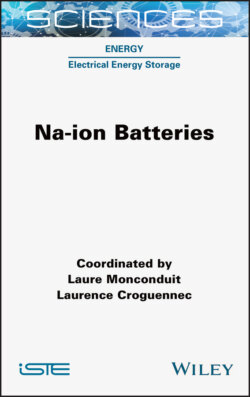Читать книгу Na-ion Batteries - Laure Monconduit - Страница 29
1.3.1.6. O’3-NaNiO2
ОглавлениеElectrochemical properties and phase transitions of O’3-NaNiO2 in Na cells were first reported by Braconnier et al. in 1982 (Braconnier et al. 1982) and re-investigated by Vassilaras et al. in 2013 (Vassilaras et al. 2013). O’3-NaNiO2 delivers a reversible capacity of ca. 100 mAh g−1 with stepwise voltage profile in the voltage range of 1.25–3.75 V (Figure 1.8). Detailed phase transitions during charge-discharge were reported by Han et al. (2014) and Wang et al. (2017a) with operando XRD measurements. The results revealed that O’3-NaNiO2 transforms into at least six phases of O’3 and P’3 during a charging process. Both the authors found that no original O’3 phase was observed on the discharging process and the irreversible phase transition was thought to cause capacity degradation during charge–discharge cycles. Unlike Ti, V, Cr, Mn and Fe, but like Co system, O’3-NaNiO2 delivers a large discharge capacity of ca. 130 mAh g−1 even after charging to the high voltage of 4.5 V versus Na (Vassilaras et al. 2013; Wang et al. 2017a). Wang et al. revealed from in situ synchrotron XRD that the Na-extracted phase of Na0.17NiO2 is irreversibly formed upon charging to 4.5 V and is partly remained in the core of the particles even after discharging to 2.0 V versus Na. Migration of nickel ions into interslab space was often observed for O3-LiNiO2 at the end of charging to 4.45 V versus Li (Croguennec et al. 2001). However, Li et al. mentioned no migration of nickel ions for O’3-NaNiO2 after charging to 4.5 V versus
Na from the unpublished HRTEM image in the literature (Li et al. 2016). The reaction mechanism of O’3-NaNiO2 might be different to that of O3-LiNiO2.
These fundamental studies are very helpful to understand the electrochemical properties of the complicated multiple transition metal systems. Transition metals usually dominate redox potential and phase transitions of O3-type layered materials. However, those of multiple 3d transition metal systems are not simple and are influenced by difference in oxygen orbital contribution to the redox reaction (Nanba et al. 2016). Not only nominal valence of transition metals but also hybridization between oxygen 2p and transition metal 3d orbitals plays a critical role in determining the redox potential of layered transition metal oxides in Na batteries. Redox potential and electrochemical activity of nickel ions vary on the other transition metal elements in NaMO2 (Nanba et al. 2016). Selection of the transition metals is, therefore, important to synthesize ternary and quaternary 3d transition metal systems exhibiting excellent electrochemical performance.
